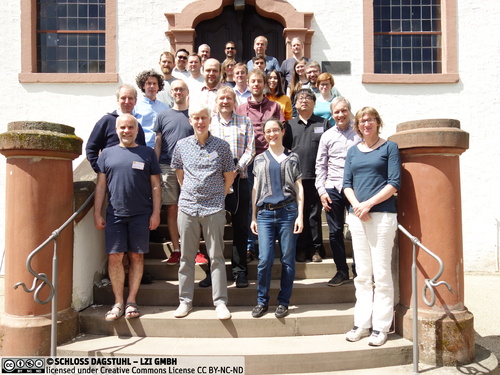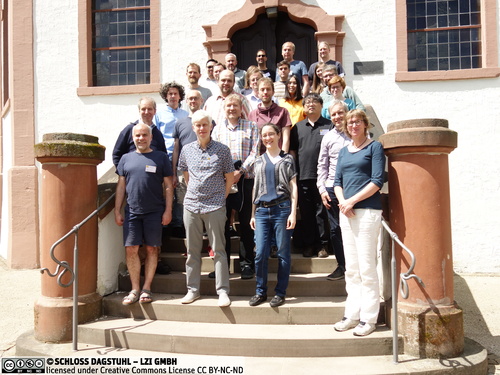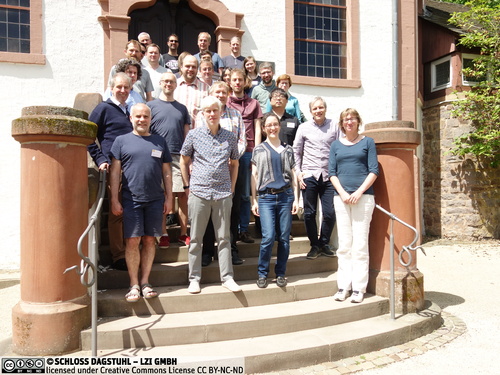Dagstuhl-Seminar 22192
Dynamic Traffic Models in Transportation Science
( 08. May – 13. May, 2022 )
Permalink
Organisatoren
- Martin Gairing (University of Liverpool, GB)
- Carolina Osorio (HEC Montréal, CA & Google - Mountain View, US)
- Britta Peis (RWTH Aachen, DE)
- David Watling (University of Leeds, GB)
Kontakt
- Andreas Dolzmann (für wissenschaftliche Fragen)
- Jutka Gasiorowski (für administrative Fragen)
Traffic assignment models are crucial for transport planners to be able to predict the traffic distributions - and thereby the congestion, environmental and social impacts - of transport policies, for example in the light of possible changes to the infrastructure (e.g. traffic light controls), to the transport services offered (e.g. the provision of public transport fleets and frequencies), or to the prices imposed on travellers (e.g. road tolls, public transport fares). The prevailing approaches used in the transportation science literature to predict such distributions can be roughly classified into mathematical approaches based on dynamic traffic assignment models (DTA) (using the methodology of flows over time) and simulation-based approaches (using large-scale microsimulations). The striking advantage of microscopic simulations over DTA models is that the latter usually ignore practically relevant side-constraints such as horizontal queueing of vehicles, the feedback of changing network conditions on user behavior, flexible departure time choice, mode choice, activity schedule choice, and such. Current simulation tools integrate all these dimensions and many more. The increase in model complexity inherent in simulations, however, is not matched by the existing DTA theory. For most simulation software, there is no "mathematical proof of concept" such as formal proofs for the following fundamental properties:
- a (dynamic) equilibrium always exists,
- an equilibrium is unique,
- an equilibrium is efficiently computable,
- there is a smooth function of equilibria with respect to parameters (such as street capacities, tolls, etc.)
In this seminar we brought together, for the third time, leading researchers from three different communities (Simulations, Dynamic Traffic Assignment and Algorithmic Game Theory) in order to bridge the gap between complex simulation based models and the existing theory. In doing so, we build on the progress made in the first two seminars, and at the same time addressed the emerging real-life challenge of modeling the new kinds of "mobility service" that are increasingly envisaged for the future, such as intelligent/dynamic ride-sharing and car-sharing, through to fully autonomous vehicles, provided potentially by a variety of competing operators.
The purpose of this third seminar was to build on the momentum, collaborations and new directions identified at the previous two seminars, following on from the impacts identified earlier. Similarly to the first two seminars, one objective was to make new advances on identifying, formulating and solving existing open problems by combining insights from the different academic fields. Thus, we continued working on themes, initiated at the previous Dagstuhl seminars, related to the representation of queuing in dynamic models and the identification of new requirements and new open problems arising from future forms of mobility and travellers' behaviour, for example, systems of autonomous vehicles, and coordinated/shared routing.
Again, the seminar was a big success. Beside forster collaboration of the last seminars of this series, the seminar stimulates new and very fruitful ones. We got laudatory feedback from many participants which is also reflected in the survey conducted by Dagstuhl.
 Martin Gairing, Carolina Osorio, Britta Peis, and David Watling
Martin Gairing, Carolina Osorio, Britta Peis, and David Watling
The transportation community (and industry) often bases traffic predictions on complex computer-based simulations that can model many elements of a real transportation system but not always resolve their properties. On the other hand, the theory of dynamic traffic assignments in terms of equilibrium existence, computability and efficiency, has not matured to the point of matching the model complexity inherent in simulations. This Dagstuhl Seminar is the third in a series that brings together leading scientists in the areas of traffic simulations (SIM), algorithmic game theory (AGT) and dynamic traffic assignment (DTA) with the goal to further close the gap between theory and simulations. We will particularly address the following topics.
Queuing representation in dynamic models. The method of representing queuing dynamics is perhaps the central decision affecting the subsequent properties of a dynamic network model. Discrete simulation models are good for reflecting complex intersections and queue spillback behaviour, yet their theoretical properties are less well understood. Somewhat at the other extreme, the bottleneck or fluid queue model gives a very simple characterisation that allows many theoretical results to be established, yet the appealing theoretical properties this gives rise to are typically lost when spatial queue spillback is included. We will explore how the theoretical boundaries of the discrete and continuous models may be further advanced.
Risk-averse traveller behaviour in dynamic models. Travellers making repeated journeys typically face unexpected traffic conditions, and experienced travellers take appropriate risk-averse strategies in their choice of route and departure time. While quite a range of models have been proposed in the transportation literature for representing such behaviour, relatively little is known about the theoretical properties of these models (relative to their risk-neutral counterparts), such as uniqueness, complexity, computation and efficiency of equilibria. We will classify and analyse the existing models and theory for such phenomena, and identify key open research questions and promising theoretical frames.
Autonomously guided vehicles in dynamic models. It is widely anticipated that future transport systems will comprise significant numbers of autonomously guided vehicles, which provides great potential for considerable benefits to both guided and unguided vehicles. However, the development of techniques for the modelling of dynamic traffic flow in such mixed conditions is still in its early stages. We will assess the state-of-the-art for such dynamic link/intersection modelling, identify desirable properties of any such mixed model, and set out new open research questions. This will include, for example, consideration of (atomic splittable) oligopolistic routing models, which seem of strong relevance but have been largely unexplored in a dynamic network setting.
Coordinated/shared routing. It is anticipated that most future mobility will be coordinated by shared use of resources, such as dynamic ride-sharing or car-sharing. This requires elements of cooperative behaviour, embedded within a non-cooperative framework. In addition, there are many time-dependent elements, such as the coordination of 'matched' journey in space and time, and the use of dynamic pricing to influence travellers to be flexible (e.g., in their desired departure time). Studying large-scale problems of this kind is a new challenge, and the potential of game theory to address this challenge has been little studied.
 Martin Gairing, Carolina Osorio, Britta Peis, and David Watling
Martin Gairing, Carolina Osorio, Britta Peis, and David Watling
- Joseph Chow (New York University, US)
- Richard Connors (University of Luxembourg, LU) [dblp]
- Katharina Eickhoff (RWTH Aachen, DE) [dblp]
- Miriam Fischer (Imperial College London, GB)
- Gunnar Flötteröd (Linköping University, SE & Swedish National Road and Transport Research Institute (VTI) - Stockholm SE) [dblp]
- Martin Gairing (University of Liverpool, GB) [dblp]
- Yiannis Giannakopoulos (Universität Erlangen-Nürnberg, DE)
- Lukas Graf (Universität Augsburg, DE) [dblp]
- Tobias Harks (Universität Augsburg, DE) [dblp]
- Martin Hoefer (Goethe-Universität - Frankfurt am Main, DE) [dblp]
- Takamasa Iryo (Tohoku University - Sendai, JP) [dblp]
- Max Klimm (TU Berlin, DE) [dblp]
- Ekkehard Köhler (BTU Cottbus-Senftenberg, DE) [dblp]
- Jannik Matuschke (KU Leuven, BE) [dblp]
- Haruko Nakao (University of Luxembourg, LU) [dblp]
- Neil Olver (London School of Economics, GB) [dblp]
- Carolina Osorio (HEC Montréal, CA & Google - Mountain View, US) [dblp]
- Dario Paccagnan (Imperial College London, GB) [dblp]
- Britta Peis (RWTH Aachen, DE) [dblp]
- Rahul Savani (University of Liverpool, GB) [dblp]
- Guido Schäfer (CWI - Amsterdam, NL) [dblp]
- Daniel Schmand (Universität Bremen, DE) [dblp]
- Alexander Skopalik (University of Twente - Enschede, NL) [dblp]
- Martin Skutella (TU Berlin, DE) [dblp]
- Martin Strehler (Westsächsische Hochschule Zwickau, DE) [dblp]
- Bernhard von Stengel (London School of Economics, GB) [dblp]
- David Watling (University of Leeds, GB) [dblp]
Verwandte Seminare
- Dagstuhl-Seminar 15412: Dynamic Traffic Models in Transportation Science (2015-10-04 - 2015-10-09) (Details)
- Dagstuhl-Seminar 18102: Dynamic Traffic Models in Transportation Science (2018-03-04 - 2018-03-09) (Details)
- Dagstuhl-Seminar 24281: Dynamic Traffic Models in Transportation Science (2024-07-07 - 2024-07-12) (Details)
Klassifikation
- Computer Science and Game Theory
Schlagworte
- dynamic traffic equilibria
- complexity of equilibrium computation
- simulation
- dynamic net- work flow theory
- network optimisation




 Creative Commons BY 4.0
Creative Commons BY 4.0
